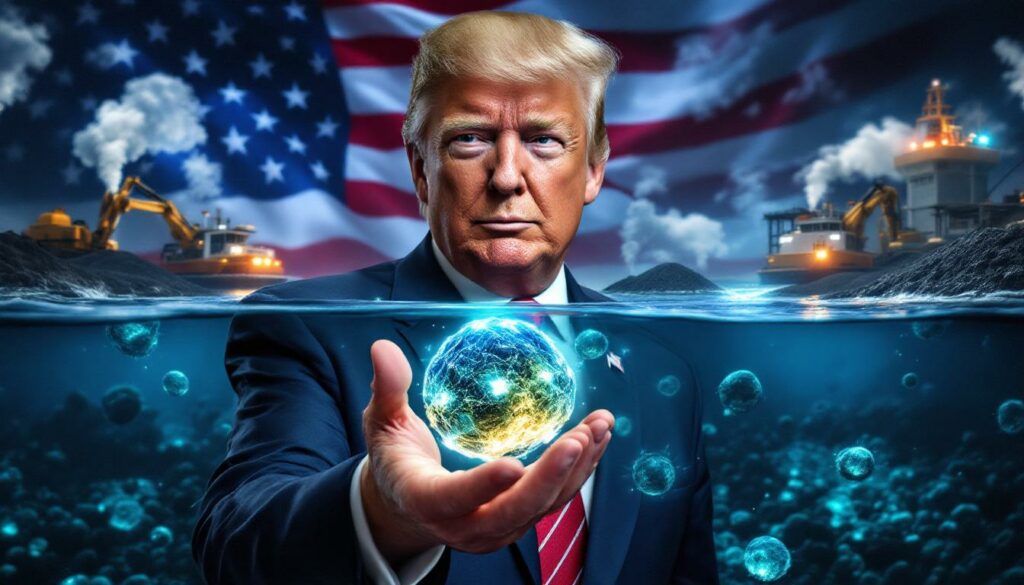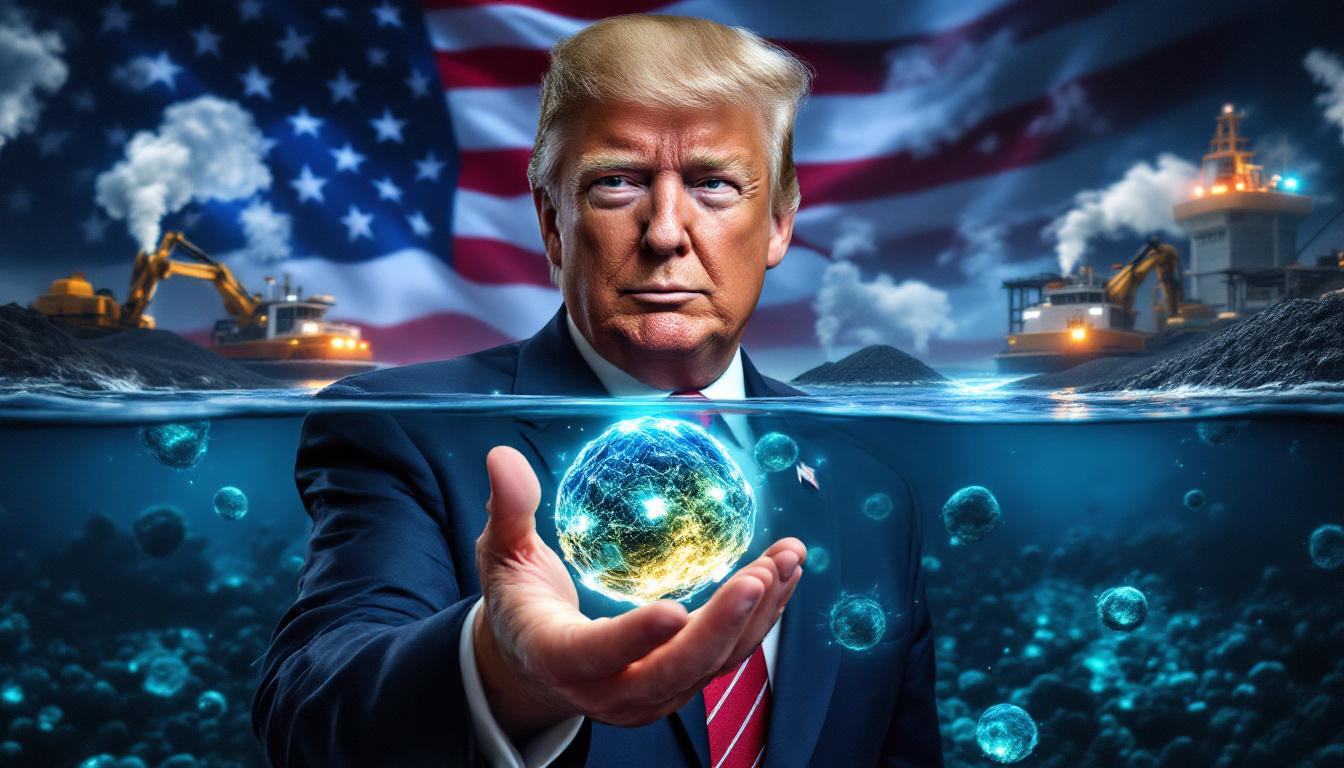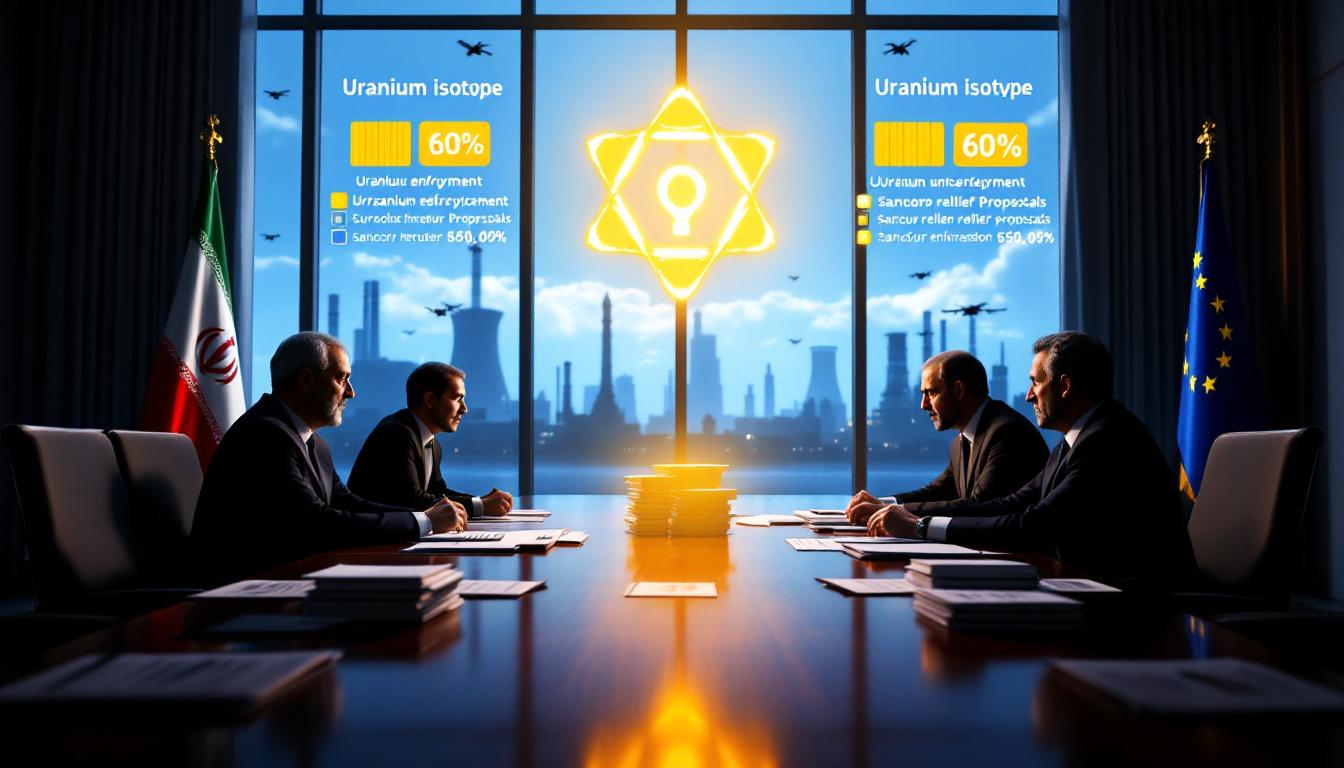Trump's Deep-Sea Mining Push Reshapes American Critical Minerals Strategy
The race for ocean floor resources has entered a new phase under President Trump's administration, with deep-sea mining emerging as a cornerstone of America's critical minerals strategy. This controversial approach aims to secure vital resources while challenging international norms around seabed governance.
The Executive Order That Changed Everything
In April 2025, President Trump issued a groundbreaking Trump executive order that fundamentally altered the landscape of deep-sea mining. This directive expedited US licensing for seabed mining operations, framing the initiative as a strategic "gold rush" specifically designed to counter China's growing influence in the critical minerals sector.
The executive order represents a significant departure from international norms, effectively bypassing the authority of the International Seabed Authority (ISA), which has spent over a decade developing regulations for mining in international waters. The Trump administration's unilateral approach leverages the fact that the United States never ratified the UN Convention on the Law of the Sea, providing legal maneuverability for independent action.
Following the executive order, The Metals Company (TMC) saw its stock surge to a 52-week high of $8.19, signaling investor confidence in this new direction for American resource policy.
Critical Minerals vs. Climate Change: The Shifting Narrative
The administration's approach marks a notable shift in how deep-sea mining is being positioned. Previously, companies like TMC (formerly DeepGreen) framed their operations primarily as environmentally beneficial efforts to support the transition away from fossil fuels.
Now, the narrative has dramatically shifted toward national security and industrial competitiveness. As Gerard Barron, CEO of TMC, stated following the executive order: "We must ensure the nation's critical minerals energy security and industrial competitiveness… China is close behind." This pivot reflects broader geopolitical tensions and the administration's focus on resource nationalism.
Unilateral Action in International Waters
Trump's executive order effectively establishes a parallel regulatory framework that allows US companies to pursue mining operations in international waters without waiting for ISA approval. This unilateral approach has created significant international tension, as it challenges the established principle that the global seabed should be managed as a common heritage of humanity.
The UN Convention on the Law of the Sea explicitly declares the seabed "the common heritage of mankind," prohibiting unilateral exploitation. However, as the US never ratified this treaty, the administration believes it has legal authority to establish its own licensing regime.
Strategic Implications for US Critical Minerals Supply
Reducing Dependency on China's Mineral Dominance
The administration's aggressive push into deep-sea mining directly addresses China's overwhelming control of critical mineral supply chains. Current statistics reveal China's commanding position:
- 74% of global cobalt ore processing capacity
- 97% of global nickel ore processing capacity located outside North America
- 80%+ capacity for refining these metals into advanced battery materials
This dominance presents a significant strategic vulnerability for the United States, particularly as demand for these minerals accelerates with the growth of electric vehicles, renewable energy systems, and advanced electronics.
Polymetallic Nodules: The Untapped Treasure
The deep seabed, particularly in the Clarion-Clipperton Zone of the Pacific Ocean, contains billions of polymetallic nodules—black, avocado-sized rocks that form over millions of years. These nodules represent:
- The world's largest estimated reserves of cobalt and nickel
- Significant deposits of copper and manganese
- Higher cobalt grades (0.3–0.5%) than many terrestrial deposits (0.1–0.2%)
- A potential alternative to land-based mining operations that often face environmental and social challenges
These nodules contain nickel, cobalt, copper, and manganese embedded in manganese oxide, with metals distributed throughout each rock rather than concentrated in veins as in terrestrial deposits. During a 2022 test, TMC collected 3,000 metric tons of nodules, demonstrating the feasibility of harvesting these resources. Furthermore, understanding the polymetallic nodules benefits is crucial for evaluating their potential economic impact.
Creating a China-Free Supply Chain
The administration's strategy aims to establish an entirely new supply chain for critical minerals that operates independently from Chinese influence. This approach aligns with Trump's broader economic nationalism and his stated desire for greater control over resource-rich regions, including expressed interest in Canada and Greenland's mineral resources.
The Department of Defense has been allocated $5.5 billion for critical minerals supply chains in the July 2025 spending bill, underscoring the administration's commitment to this strategy.
Companies Leading the Deep-Sea Mining Race
The Metals Company (TMC): First Mover Advantage
TMC has positioned itself at the forefront of this new frontier:
- Filed the world's first application to mine the seabed in international waters under US law
- Secured an $85 million investment from a Korean metals processor
- Completed a successful prototype test in 2022, collecting 3,000 metric tons of nodules
- Experienced a significant stock price surge, reaching a 52-week high of $8.19 in July 2025
The company has aggressively pursued a first-mover advantage, telling investors it could begin commercial operations within a year of receiving a US license. However, industry experts question this ambitious timeline given the technological and logistical challenges involved.
Impossible Metals: The AI-Driven Approach
This Silicon Valley startup is pursuing a different technological approach:
- Applied for a license to explore and mine nodules in US waters near American Samoa
- Aims to raise $1 billion in funding
- Developing the "Eureka" collector that uses AI and robotic claws to selectively harvest nodules
- Focusing on minimizing environmental impact by avoiding nodules inhabited by marine organisms
Impossible Metals' CEO Oliver Gunasekara acknowledges the challenges ahead, stating, "It's going to take some time" before commercial mining operations begin. The company's technology represents a potentially more environmentally sensitive approach, though at the cost of lower collection efficiency.
Lockheed Martin: Defense Giant Enters the Arena
The US defense contractor has recently signaled its interest in the sector:
- In discussions to provide seabed miners access to Pacific areas it licenses from the US
- Brings significant technological expertise and government connections
- Represents the entrance of major defense industry players into the deep-sea mining space
Lockheed's involvement signals the growing intersection between national security interests and critical minerals supply chains, potentially accelerating technological development in the sector.
Technological Challenges for Deep-Sea Mining
Harvesting Technology: Still in Development
Despite promising tests, commercial-scale deep-sea mining technology faces significant hurdles:
- Current prototypes operate at limited capacity and duration
- Full-scale operations require machines capable of working continuously at depths of 4 kilometers
- Equipment must withstand crushing pressure and operate reliably far from shore
- TMC's technology partner Allseas estimates at least two years to engineer full-scale systems
The technological gap between current capabilities and commercial requirements remains substantial. Operating in the deep ocean presents unique engineering challenges that will require significant investment and innovation to overcome.
Processing Innovation: The Metallurgical Challenge
Extracting valuable metals from polymetallic nodules presents unique processing challenges:
- Unlike terrestrial ores, nodules contain multiple metals distributed throughout each rock
- No commercial facilities currently process this specific combination of minerals
- Viridian Biometals is exploring innovative biological processing using rock-breathing microbes
- Bioleaching approaches could reduce energy use by 50% compared to traditional smelting
These biological approaches represent potentially groundbreaking innovations in mineral processing, offering both environmental and economic advantages if successfully scaled.
US Processing Capacity: The Missing Link
The US currently lacks the domestic infrastructure to process nodules:
- No existing US facilities can process and refine nodule minerals
- Building a single processing facility would cost several billion dollars
- Development timeline could stretch to a decade for full production
- Metallurgical expertise has declined in the US since the 1980s
As Corby Anderson from the Colorado School of Mines notes, "We are decades behind" in metallurgical expertise. This knowledge gap represents a significant bottleneck in developing a complete domestic supply chain for critical minerals from the seabed.
Legal and International Implications
ISA Opposition to Unilateral Mining
The International Seabed Authority and its 169 member nations (plus the EU) strongly oppose unilateral mining:
- The UN Convention on the Law of the Sea prohibits unilateral mining
- ISA is mandated to administer the global seabed for humanity's benefit
- Mining royalties are meant to be divided among member states
- 37 ISA countries support a moratorium until environmental impacts are better understood
Ocean Litigation Attorney Samantha Robb emphasizes that "All parties have a legal obligation to ensure mining only occurs through the ISA," highlighting the international legal consensus against unilateral action.
Potential Legal and Commercial Barriers
Companies operating under US licenses face significant obstacles:
- International recognition issues could affect logistics, processing, and market access
- TMC acknowledged in securities filings that US licenses wouldn't be recognized internationally
- Partner companies like Pacific Metals Company have stated they would only process nodules once international rules are finalized
- The ISA may impose trade restrictions or other penalties on minerals obtained through unilateral mining
ISA Secretary-General Leticia Carvalho has warned that unilateral mining poses "reputational and legal concerns" for companies involved, suggesting potential consequences beyond simple regulatory issues.
The Vessel Ownership Challenge
US seabed mining licenses would require American-built and owned vessels:
- The specialized Hidden Gem vessel used by TMC is Dutch-owned and Swiss-registered
- Only eight US ocean-going bulk cargo carriers exist, with seven near the end of their lifespan
- Building new specialized mining vessels would add significant costs and delays
- Technology suppliers like Allseas face political pressure not to support unilateral mining
This vessel shortage represents a concrete logistical challenge to rapid development of US-based seabed mining operations, potentially delaying commercial operations for years.
Environmental Considerations at Stake
Deep-Sea Ecosystems: Largely Unexplored
The areas targeted for mining contain unique and vulnerable ecosystems:
- Scientists are only beginning to understand deep-sea habitats
- An estimated 30-40% of deep ocean life in targeted areas live on nodules
- These ecosystems have developed over millions of years with minimal disturbance
- Recovery rates from disturbance are extremely slow in deep-sea environments
The limited scientific understanding of these ecosystems makes it difficult to fully assess the potential impacts of large-scale mining operations, leading many scientists to call for more research before commercial operations begin.
Sediment Plumes and Habitat Disruption
Mining operations create environmental disturbances:
- Harvesting machines generate sediment plumes that can spread 20-100 km beyond mining areas
- These plumes can smother filter-feeding organisms far from the mining site
- Removal of nodules eliminates habitat for numerous species
- Light and noise pollution in normally dark, quiet environments
- Potential for species extinction before they're even discovered
These environmental impacts could extend far beyond the immediate mining area, affecting broader ocean ecosystems in ways that are difficult to predict or mitigate.
Alternative Approaches to Minimize Impact
Some companies are developing technologies aimed at reducing environmental harm:
- Impossible Metals' Eureka system uses AI to avoid harvesting nodules with visible marine life
- Selective harvesting approaches could preserve more habitat
- Extended environmental baseline studies before commercial operations
- Establishment of protected areas within mining regions
While these approaches may reduce impacts, they don't eliminate them entirely, and many scientists remain skeptical about whether commercial-scale mining can be conducted without significant environmental harm.
Economic Viability of Deep-Sea Mining
Market Uncertainties for Nodule Minerals
The economic case for deep-sea mining faces several challenges:
- Battery technology is evolving rapidly, potentially reducing demand for certain minerals
- Metal prices fluctuate significantly, affecting project economics
- Land-based mining continues to expand production
- Processing costs for the unique mineral combination in nodules remain uncertain
These market uncertainties make it difficult to accurately forecast the long-term profitability of seabed mining operations, particularly given the high upfront capital requirements.
Timeline to Commercial Production
Despite ambitious claims, realistic timelines suggest a longer horizon:
- TMC has told investors it expects to begin mining within a year of receiving a license
- Pacific Metals doesn't expect full production until 2029 at the earliest
- Impossible Metals projects commercial operations no earlier than the 2030s
- Regulatory and legal challenges could further extend these timelines
The gap between the aggressive timelines presented to investors and the realistic technological and regulatory hurdles raises questions about when commercial-scale seabed mining will actually begin.
Investment and Funding Landscape
The sector is attracting significant investment despite uncertainties:
- TMC's stock reached a 52-week high following Trump's executive order
- Impossible Metals aims to raise $1 billion
- The recent US tax and spending bill allocates $5.5 billion to the Department of Defense for critical minerals supply chains
- Korean and Japanese metals companies are making strategic investments
This influx of capital reflects growing investor confidence in the sector, driven by both strategic concerns about mineral supply chains and the potential for significant returns if commercial operations succeed.
What's Next for Deep-Sea Mining Under Trump?
Regulatory Framework Development
The administration is likely to continue developing its parallel regulatory structure:
- Establishment of specific licensing requirements and environmental standards
- Potential tax incentives for domestic processing facilities
- Coordination between multiple agencies including Defense, Commerce, and Interior Departments
- Possible executive actions to accelerate permitting processes
These regulatory developments will shape the economic and operational landscape for companies entering the sector, potentially creating a more favorable environment for rapid development.
International Response and Diplomacy
The US approach will face ongoing international challenges:
- ISA delegates are expected to make public statements addressing unilateral mining
- Potential trade restrictions or sanctions against products derived from unilateral mining
- Diplomatic pressure on US allies not to support or facilitate operations
- Possible legal challenges in international courts
The international community's response will significantly impact the commercial viability of US-licensed seabed mining operations, particularly regarding access to global markets and processing facilities.
Technology and Infrastructure Investment
Significant investment will be needed to build a complete supply chain:
- Development of US-flagged specialized mining vessels
- Construction of domestic processing and refining facilities
- Recruitment and training of metallurgical expertise
- Research and development funding for more efficient extraction and processing technologies
The Department of Defense's $5.5 billion allocation for critical minerals supply chains may accelerate some of these investments, but building a complete domestic supply chain will require sustained funding over many years.
How Trump's Policy Fits Into Broader US Resource Strategy
Critical Minerals as National Security Priority
The deep-sea mining push represents one element of a comprehensive approach:
- Expansion of the strategic minerals reserve
- Development of domestic mining for lithium, rare earths, and other critical minerals
- Strengthening of supply chains with allied nations
- Reduced reliance on potentially hostile suppliers
This approach reflects a broader shift toward treating mineral resources as strategic assets rather than simply economic commodities, with national security concerns driving policy decisions. The administration has also implemented a big pivot strategy to address these challenges more comprehensively.
Reshaping Global Resource Geopolitics
Trump and deep-sea mining could fundamentally alter resource politics:
- Challenge to the principle of common heritage of mankind for seabed resources
- Potential for a fragmented regulatory approach with multiple countries issuing licenses
- New alliances forming around resource extraction and processing
- Acceleration of resource nationalism globally
These geopolitical shifts could have far-reaching implications for international relations, potentially creating new tensions and alliances centered around control of critical mineral resources.
Integration With Industrial Policy
The administration is connecting resource acquisition to broader economic goals:
- Support for domestic manufacturing that relies on critical minerals
- Development of advanced battery production capacity
- Strengthening of defense industrial base
- Creation of high-wage jobs in mining, processing, and manufacturing
This integration of resource policy with broader industrial strategy reflects the administration's focus on rebuilding American manufacturing capacity and reducing dependencies on foreign suppliers. These changes are part of a broader mining industry evolution that is reshaping global resource markets.
FAQ: Deep-Sea Mining Under Trump
What exactly are polymetallic nodules?
Polymetallic nodules are black, avocado-sized rocks that form over millions of years on the ocean floor as minerals precipitate from seawater around small objects like whale bones or shark teeth. They contain valuable metals including nickel, cobalt, copper, and manganese, with each nodule containing particles of all these metals embedded throughout.
How does the US position on deep-sea mining differ from international law?
The US never ratified the UN Convention on the Law of the Sea, which established the International Seabed Authority (ISA) as the governing body for seabed mining. While the US had generally adhered to its provisions as an observer, Trump's executive order creates a parallel licensing system that bypasses the ISA's authority and contradicts the treaty's principle that the seabed is the common heritage of mankind.
What environmental concerns do scientists have about deep-sea mining?
Scientists worry about several environmental impacts: destruction of habitat for deep-sea organisms (many of which live directly on nodules), creation of sediment plumes that can travel far beyond mining areas, disruption of carbon sequestration processes in deep-sea
Ready to Capitalise on the Next Major Mineral Discovery?
Stay ahead of the market with Discovery Alert's proprietary Discovery IQ model, delivering instant notifications on significant ASX mineral discoveries and turning complex data into actionable insights. Understand why major mineral discoveries can lead to significant returns by exploring our dedicated discoveries page.




